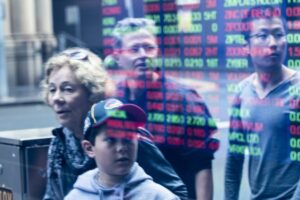Think markets are in for a ‘soft landing’? Not so fast

Save articles for later
Add articles to your saved list and come back to them any time.
The past year and a bit have been a rollercoaster for stock market investors. In January 2022, the regime that the market had been in clearly changed, and no longer was it just a simple matter of ‘buy-the-dip’.
Instead, a variety of macro forces buffeted investors in both directions, and it’s been difficult for longer-term investors to get a clear read on risk vs reward during this time.
Market watchers believe we’re coming off the worst of our high inflation troubles, but the worst could still be to come.Credit: Louie Douvis
However, if we turn to the underlying macro fundamentals, we can map things out into three broad phases, making it much easier for investors to look through the daily noise.
In a nutshell, phase one is behind us, phase two is where we are now, and phase three is still to play out.
Phase one: January 2022 was the start of the first phase. It was all about the fact that the business cycle had peaked with growth still strong but starting to decelerate, and inflation was high and starting to broaden out. Central banks had finally realised that inflation was not transitory and that they had a fight on their hands.
As central banks hiked interest rates aggressively, this led to stock price-to-earnings ratios contracting and stock prices falling. This was not yet about earnings.
Phase two: This is where we have been since October 2022. This phase is all about the market cheering that inflation has likely peaked, and the end appears in sight for central banks hiking interest rates.
Added to this has been China’s re-opening, the US dollar and bond yields coming off their peaks, and very low unemployment fuelling the ‘soft landing’ narrative.
A soft landing is where growth slows without a significant rise in unemployment. Some are calling it “immaculate disinflation”, and it appears markets would love to price in this perfect scenario.
Phase three: This is still ahead of us, and whilst we can’t predict the future, we can look to certain indicators to give us a read on the probability of how this plays out based on historical correlations. As mentioned above, the market appears to want to be pricing in the so-called ‘soft landing’ as a done deal, with phase three the start of a new bull market.
Not so fast. The first thing to understand is that markets always seem to price in a soft landing near the end of a rate hike cycle, as employment is nearly always strong at that point (it is the last thing to buckle).
The second thing to really understand is that the vast majority of all that fiscal tightening in 2022 is still mostly yet to be felt by the real economy. Historically, it acts on a significant lag, and we are not yet in the window where this really hits. That is still ahead of us, with the second half of 2023 where things start to really get interesting.
While phase one was all about the inflation and rates shock, and phase two has seen markets recover on the view inflation has peaked and the end of rate hikes is in sight, risk has not gone away.
Phase three is still ahead of us, and is where the lagged, negative effect of last year’s tightening comes into play. The unknown right now is exactly if or when this enters the psyche of the market.
Whilst there can be various catalysts, employment will likely be the key. If unemployment stays low, then markets are more likely to muddle through. However, if job losses spike, risk and volatility will likely rise significantly as markets start to price in the ‘hard landing’ scenario.
- Advice given in this article is general in nature and is not intended to influence readers’ decisions about investing or financial products. They should always seek their own professional advice that takes into account their own personal circumstances before making any financial decisions.
Graham Parkes is the founder and chief macro analyst of www.themacroreport.com.au.
Most Viewed in Money
From our partners
Source: Read Full Article

